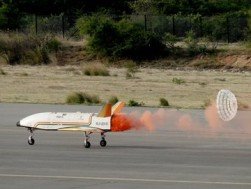The Indian Space Research Organisation (ISRO) has once again made history by successfully completing the third and final landing experiment of its Reusable Launch Vehicle (RLV), named ‘Pushpak’. This landmark event occurred on June 23, 2024, at 07:10 IST at the Aeronautical Test Range (ATR) in Chitradurga, Karnataka. The success of this mission marks a significant milestone in ISRO’s journey towards developing reusable space technology, which is poised to revolutionize the future of space exploration.

1. Significance of the RLV Landing Experiment:
The RLV Landing EXperiment (LEX) series, including LEX-01, LEX-02, and now LEX-03, has been designed to test and validate the autonomous landing capabilities of the RLV under progressively challenging conditions. The successful completion of these tests demonstrates ISRO’s growing expertise in reusable space vehicle technology.
a. Challenging Conditions of LEX-03
- During the LEX-03 mission, an Indian Air Force Chinook Helicopter released the winged vehicle, Pushpak, at an altitude of 4.5 km. Unlike the previous experiments, LEX-03 faced more severe wind conditions and required Pushpak to perform cross-range correction maneuvers from a release point 4.5 km away from the runway. Despite these challenges, Pushpak executed a precise horizontal landing at the runway centerline, showcasing its advanced autonomous capabilities.
b. Advanced Technologies and Systems
- Pushpak’s landing velocity exceeded 320 kmph, significantly higher than the landing speeds of commercial and fighter aircraft, which are typically around 260 kmph and 280 kmph, respectively. After touchdown, a brake parachute reduced the vehicle’s speed to nearly 100 kmph, and then the landing gear brakes engaged. The vehicle’s rudder and nose wheel steering system ensured a stable and precise ground roll along the runway.
c. Critical Technology Validation
- The mission simulated the approach and landing interface and high-speed landing conditions for a vehicle returning from space. This simulation was crucial for validating the advanced guidance algorithm designed for longitudinal and lateral plane error corrections, which is essential for future orbital re-entry missions. The RLV-LEX utilized multi-sensor fusion, incorporating sensors like the Inertial sensor, Radar altimeter, etc.
d. Robust Design and Reusability
- One of the standout features of the LEX-03 mission was the reuse of the winged body and flight systems from the LEX-02 mission without any modifications. This demonstrated the robustness of ISRO’s design and its capability to reuse flight systems for multiple missions, a crucial aspect for the economic viability of reusable launch vehicles.
2. Collaborative Effort and Contributions:
The LEX-03 mission was led by the Vikram Sarabhai Space Centre (VSSC) and involved collaboration with multiple ISRO centers, including the Space Applications Centre (SAC), ISRO Telemetry, Tracking and Command Network (ISTRAC), Satish Dhawan Space Centre (SDSC-SHAR), and the Inertial Systems Unit (IISU). The mission also received significant support from the Indian Air Force (IAF), Aeronautical Development Establishment (ADE), Aerial Delivery Research and Development Establishment (ADRDE), Regional Centre for Military Airworthiness (RCMA) under Centre for Military Airworthiness and Certification (CEMILAC), National Aerospace Laboratories (NAL), Indian Institute of Technology, Kanpur, Indian aerospace industrial partners, Indian Oil Corporation of India, and Airport Authority of India.
Leadership and Acknowledgements
- Shri. S Somanath, Chairman of ISRO and Secretary of the Department of Space, congratulated the team for their relentless efforts and the success of the mission. Dr. S Unnikrishnan Nair, Director of VSSC, emphasized that this consistent success boosts ISRO’s confidence in the critical technologies essential for future orbital re-entry missions. Shri. J Muthupandian served as the Mission Director, and Shri. B Karthik was the Vehicle Director for this successful mission.
3. Future Implications of RLV Technology:
The successful demonstration of the RLV technology, particularly the autonomous landing capabilities under challenging conditions, signifies a monumental step forward for ISRO. This achievement not only underscores ISRO’s capability in developing cutting-edge space technology. ISRO paves the way for more cost-effective and sustainable space missions in the future.
a. Revolutionizing Space Missions
- Space agencies see reusable launch vehicles as the future of space exploration due to their potential to significantly reduce the cost of accessing space. By reusing critical components of the launch vehicle, ISRO aims to make space missions more economical and sustainable. This will be particularly beneficial for launching satellites, space exploration missions, and potentially even manned missions in the future.
b. Enhancing India’s Space Capabilities
- The advancements in RLV technology will enhance India’s competitiveness in the global space industry. With the successful completion of the LEX series, ISRO has demonstrated its ability to develop and operate sophisticated space technologies, positioning India as a key player in the international space community.
Conclusion
The successful third and final landing experiment of the Reusable Launch Vehicle ‘Pushpak’ marks a significant achievement for ISRO and the future of space exploration. The mission’s success under challenging conditions reaffirms ISRO’s expertise in critical space technologies and its commitment to innovation and excellence. This milestone brings ISRO one step closer to realizing the dream of reusable space vehicles, promising a new era of cost-effective and sustainable space missions.
FAQs:
1. What is the Reusable Launch Vehicle (RLV)?
The RLV is a spacecraft designed for multiple launches to lower the cost of space missions.
2. What was the goal of the RLV Landing Experiment (LEX)?
LEX aimed to test the RLV’s ability to land autonomously under various conditions.
3. How many RLV landing experiments were done?
Three landing experiments: LEX-01, LEX-02, and LEX-03.
4. What were the challenges in the LEX-03 mission?
LEX-03 faced severe wind conditions and required the RLV to perform cross-range corrections from 4.5 km away.
5. How was Pushpak deployed in the LEX-03 mission?
Pushpak was released from an Indian Air Force Chinook Helicopter at 4.5 km altitude and landed autonomously.
6. What technologies were tested in LEX-03?
The mission validated advanced guidance algorithms and multi-sensor fusion involving various sensors like the Inertial sensor and NavIC.
7. What was notable about reusing the winged body and flight systems in LEX-03?
The same components from LEX-02 were reused, showing the reliability of ISRO’s design.
8. Who were the main contributors to the LEX-03 mission?
The mission was led by VSSC and supported by other ISRO centers, the Indian Air Force, and various research and industrial partners.
9. Who were the key leaders of the LEX-03 mission?
Shri. S Somanath (ISRO Chairman), Dr. S Unnikrishnan Nair (VSSC Director), Shri. J Muthupandian (Mission Director), and Shri. B Karthik (Vehicle Director).
10. What are the future benefits of RLV technology?
RLV technology can reduce space mission costs and make launches more sustainable.
11. How does the success of RLV missions affect India’s space program?
Successful RLV missions enhance India’s global standing in space technology and demonstrate ISRO’s advanced capabilities
